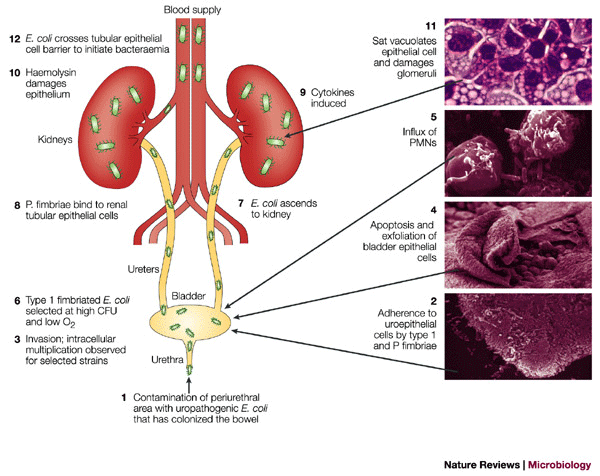
你也可以參考這篇:[期刊轉載][JAMA]Urinary Tract Infection
Diagnosis
There is overall agreement that the classic signs and symptoms of uncomplicated LUTI include: dysuria, frequent and urgent urination, suprapubic pain or tenderness, and possibly hematuria. There is also agreement that the presence of vaginal symptoms (e.g., vaginitis, urethritis) should prompt alternative diagnoses.
According to ACOG, women with frequent recurrences and prior confirmation by diagnostic tests who are aware of their symptoms may be empirically treated without recurrent testing for pyuria. In women without a history of a laboratory-confirmed UTI, however, ACOG states that an office visit for urinalysis or dipstick testing is appropriate.
There is overall consensus that urine culture is not indicated in the vast majority of initial LUTI cases. The groups agree, however, that culture may be indicated in recurrent UTI, patients unresponsive to treatment, or in patients with complicating factors.
Prevention of Recurrent UTI
ACOG and the [SOGC] address antibiotic therapy for the prevention of recurrent UTI, and agree that the primary strategies generally considered are: continuous antimicrobial prophylaxis, postcoital prophylaxis, and patient-initiated self-treatment. For women with frequent recurrences (SOGC specifies ≥2 UTIs in 6 months or ≥3 UTIs in 12 months), the groups agree that it is appropriate to offer continuous daily antibiotic prophylaxis for a 6- to 12-month period. With regard to selection of the antibiotic, both groups recommend nitrofurantoin, TMP, TMP/SMX (cotrimoxazole), and fluoroquinolones. SOGC also cites cephalexin; ACOG also cites fosfomycin tromethamine. The groups agree that women with recurrences associated with sexual intercourse may be offered postcoital prophylaxis—a single antibiotic dose taken after sexual intercourse—as an alternative to continuous therapy. There is further agreement that women with recurrent UTIs are often aware of symptom onset, and that self-initiated 3-day course of antibiotic therapy can be a viable option for these patients. SOGC specifies that self-treatment should be restricted to compliant and motivated patients in whom recurrent UTIs have been clearly documented. The groups agree that if symptoms do not improve within 48 hours, women should contact their provider for a clinical evaluation. SOGC further recommends that prophylaxis for recurrent UTI should not be undertaken until a negative culture 1 to 2 weeks after treatment has confirmed eradication of the UTI.
With regard to non-antibiotic interventions, all three groups agree that cranberry products are useful for prophylaxis of recurrent UTI. ACOG and SOGC agree that sexually active women suffering from recurrent UTIs and using spermicide should be encouraged to consider using an alternative form of contraception. ACOG and SOGC also address the use of vaccines and probiotics (vaginal lactobacilli application) for recurrent UTI, which both groups found insufficient evidence to recommend. Other interventions addressed by ACOG include aggressive hydration, postcoital voiding, and douching/wiping techniques, all of which it found insufficient evidence to recommend.
According to ACOG, large, randomized trials are required before exogenous estrogen therapy can be conclusively recommended for UTI recurrence prevention. ACOG and SIGN also address methenamine hippurate. [ACOG] states that a meta-analysis reviewing 11 trials using methenamine hippurate found that, although well tolerated, there was not enough evidence to conclusively support its use for UTI prophylaxis.
Treatment
There is overall agreement that three days of antibiotic therapy is the preferred duration for treating uncomplicated LUTI. Recommendations regarding antibiotic selection differ, however. ACOG cites 3 days of TMP/SMX as the preferred therapy, noting that in areas where resistance exceeds 15-20%, TMP alone or a fluoroquinolone [ciprofloxacin, levofloxacin, norfloxacin, gatifloxacin]) should be used. SOGC confirms the effectiveness of 3-day regimens of TMP, TMP/SMX, or a fluoroquinolone, and notes these are the agents generally recommended for empiric therapy. According to SOGC, given the increasing prevalence of TMP/SMX resistance among uropathogens, it is important to examine risk factors predicting in vitro resistance (diabetes, recent hospitalization, antibiotic use in the past 3-6 months, recent TMP/SMX use). SOGC states that fluoroquinolones can become a reasonable first-line treatment for women who have or are suspected of having antimicrobial resistance or of being allergic to or not tolerating more conventional therapy, and for women in areas where resistance to TMP/SMX is >15% to 20%. Other reasonable empiric choices cited by ACOG and SOGC include a seven day course of nitrofurantoin or a single-dose of fosfomycin. ACOG and SOGC agree that ampicillin and sulfonamides generally should not be used as for empiric therapy.
SIGN, in contrast, recommends a 3-day regimen of either TMP or nitrofurantoin as first-line therapy, noting that there is no clear first choice alternative to these two antibiotics. Additionally, SIGN states that states that quinolones should not be used for empirical treatment of LUTI.
[Comparison of Recommendations]
National Guideline Clearinghouse (NGC). Guideline synthesis: Diagnosis and management of lower urinary tract infection. In: National Guideline Clearinghouse (NGC) [Web site]. Rockville (MD): Agency for Healthcare Research and Quality (AHRQ); 2008 Jan (revised 2011 Apr). [cited 2012 Jan 04]. [Link to free full-text Guideline Synthesis online]





 留言列表
留言列表
 線上藥物查詢
線上藥物查詢 